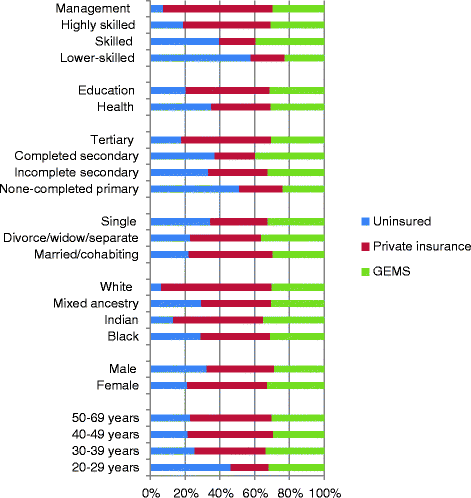Social health insurance contributes to universal coverage in South Africa, but generates inequities: survey among members of a government employee insurance scheme
- PMID: 29301537
- PMCID: PMC5755208
- DOI: 10.1186/s12939-017-0710-z
Social health insurance contributes to universal coverage in South Africa, but generates inequities: survey among members of a government employee insurance scheme
Abstract
Background: Many low- and middle-income countries are reforming their health financing mechanisms as part of broader strategies to achieve universal health coverage (UHC). Voluntary social health insurance, despite evidence of resulting inequities, is attractive to policy makers as it generates additional funds for health, and provides access to a greater range of benefits for the formally employed. The South African government introduced a voluntary health insurance scheme (GEMS) for government employees in 2005 with the aim of improving access to care and extending health coverage. In this paper we ask whether the new scheme has assisted in efforts to move towards UHC.
Methods: Using a cross-sectional survey across four of South Africa's nine provinces, we interviewed 1329 government employees, from the education and health sectors. Data were collected on socio-demographics, insurance coverage, health status and utilisation of health care. Multivariate logistic regression was used to determine if service utilisation was associated with insurance status.
Results: A quarter of respondents remained uninsured, even higher among 20-29 year olds (46%) and lower-skilled employees (58%). In multivariate analysis, the odds of an outpatient visit and hospital admission for the uninsured was 0.3 fold that of the insured. Cross-subsidisation within the scheme has provided lower-paid civil servants with improved access to outpatient care at private facilities and chronic medication, where their outpatient (0.54 visits/month) and inpatient utilisation (10.1%/year) approximates that of the overall population (29.4/month and 12.2% respectively). The scheme, however, generated inequities in utilisation among its members due to its differential benefit packages, with, for example, those with the most benefits having 1.0 outpatient visits/month compared to 0.6/month with lowest benefits.
Conclusions: By introducing the scheme, the government chose to prioritise access to private sector care for government employees, over improving the availability and quality of public sector services available to all. Government has recently regained its focus on achieving UHC through the public system, but is unlikely to discontinue GEMS, which is now firmly established. The inequities generated by the scheme have thus been institutionalised within the country's financing system, and warrant attention. Raising scheme uptake and reducing differentials between benefit packages will ameliorate inequities within civil servants, but not across the country as a whole.
Keywords: Access; Government employees; Social health insurance; South Africa; Universal health coverage; Utilization.
Conflict of interest statement
Ethics approval and consent to participate
Study procedures received ethics clearance from University the Witwatersrand (Human Research Ethics Committee (Medical) Certificate number M080103), as well as permissions from the relevant Provincial Department of Health bodies. All respondents provided signed informed consent.
Consent for publication
Not applicable.
Competing interests
None of the authors have a competing interest in the study.
Publisher’s Note
Springer Nature remains neutral with regard to jurisdictional claims in published maps and institutional affiliations.
Figures
References
-
- World Health Organization . Social health insurance: sustainable health financing, universal coverage and social health insurance. Geneva: World Health Organization; 2005.
-
- World Health Organization . Making fair choices n the path to universal health coverage: final report of the WHO consultative group on equity and universal health coverage. Geneva: World Health Organisation; 2014.
-
- World health Organization, The World Bank . Tracking universal health coverage. Geneva: World Health Organization; 2015.
Publication types
MeSH terms
Grants and funding
LinkOut - more resources
Full Text Sources
Other Literature Sources
Medical


